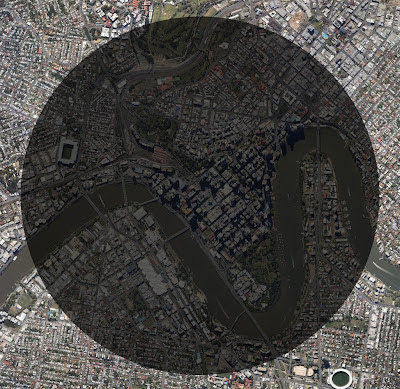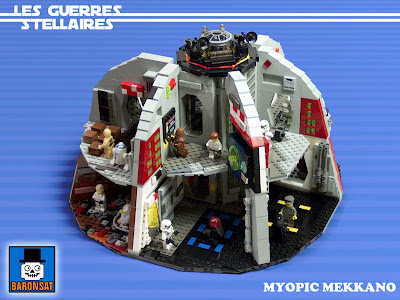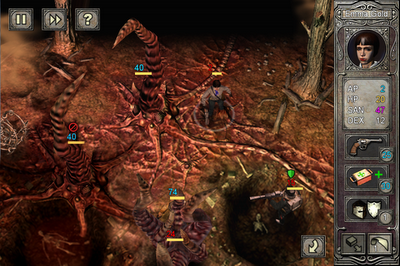Recently, I watched a couple of episodes of
Breaking Bad, since the show has gained such rave reviews. For whatever reason, the series left me cold—I just couldn't seem to care about the characters or their fates.
I've written it off now as "not for me", but I did find myself wondering what the show needed to get me in. I tried to think of twenty different takes on the show that might have got me interested, and ended up with twenty-two.
That's two extra story ideas for you! Absolutely free!I make no claim of originality :) Many of these are ideas that have been explored elsewhere, and some readers will be able to identify the origin of some specific ideas from some of my favourite shows :) Some of the ideas are quite similar to others on the list.
Which one do you like the best? What do you think would be the worthiest repositioning of
Breaking Bad?
I've created a survey on SurveyMonkey: if I get more than ten responses within the next two weeks, I'll publish the outcome!
1. While scouting out a potential location for a new meth lab in the desert, Walt and Jesse witness the test of a secret hypersonic hunter-killer drone. It isn't long before they're pursued by both the CIA and Lockheed-Martin's own corporate security. They are sheltered and hidden by a group of anarchist hackers devoted to exposing the drone's existence.
2. Walt creates a new, well received, and profitable meth recipe that sells extremely well. Not long after, repeated users begin to suffer from nightmares so terrible that eventually they cannot sleep at all. Death soon follows, with all victims exhibiting the same unusual physical trauma: a small puncture wound in the back of the neck that extends right into the brain stem. Walt is abducted by a strange cult that forces him to continue producing this recipe. As the stars reach a particular alignment in the heavens, the cultists are distributing the drug to humanity, in order to offer the people of earth as a sacrifice to their strange, alien god!
3. Walt stumbles across a completely new drug which even in small doses produces intense euphoria in its users, without any side effects or physical addiction. Moreoever, it can be produced easily and cheaply using home ingredients. Despite his best efforts, the recipe gets out and soon millions of people around the world are spending each hour of the day completely blissed out. As society begins to crumble, Walt searches for a way to block the drug's effects.
4. Driven into hiding in the desert, Walt and Jesse are awakened early one morning by a loud bang. At dawn, scouting for the source of the noise, they find what appears to be a crashed aircraft of unusual design. Searching the wreck for survivors, they find the bodies of creatures of clearly extraterrestrial origin. One of the aliens is still alive but apparently wounded. Despite Jesse's misgivings, Walt decides to take the alien back to their hideout and there nurses it back to health, trying to learn to communicate with it in the universal language of chemistry. Walt helps the alien contact its own kind. When the rescue ship arrives, the aliens offer to repair Walt's body, which he accepts. They also offer to take him with them on their exploration of the galaxy, which he also accepts. Jesse goes along to, against his better judgement, to offer the aliens a contrasting view of humanity.
5. Starts out as above, but this time there is no rescue ship, and the crash has not gone unnoticed. The skies are soon humming with black, unmarked helicopters. Walt and Jesse are now on the run from the US government's alien hunters, while their new friend is still injured from the crash!
6. While exploring some caves in the desert to use as a storage depot, Walt and Jesse stumble upon a scantily dressed woman lying unconscious. They give her water and revive her. They discover that she doesn't seem to speak any English, but using his knowledge of chemistry, Walt recognises some of her words as Greek. They follow her tracks back into one of the caves. As they delve deeper and deeper, they become aware of a strange glow up ahead. They emerge into broad daylight from a cave mouth in the side of a mountain and see a Greek-looking city sprawled out beneath them. They soon learn that they are inside the earth, and this is where the Atlanteans fled! The series depicts Walt's and Jesse's adventures exploring Atlantean society and in aiding the Atlanteans in their struggle against the lizardpeople with whom they share the Earth's core!
7. All over New Mexico, the bodies of young, recently dead people are returning to life: awakening with a terrifying hunger for human flesh! The only link between them? These young folk had all used meth from one of Walt's recent batches: and this was a big batch! Jesse discovers that only total incineration can stop the undead and Walt gets to work on producing napalm for the flame throwers with which he and Jesse will roam the state, cleansing it of the menace.
8. People who had used meth from one of Walt's recent batches report disturbing hallucinations. A dissatisfied dealer tracks down Walt and forces him to take a dose himself. Walt sees shadowy, flickering figures around him and realises that these are not hallucinations, but ghosts. Soon demand for this recipe skyrockets, because even people who wouldn't normally use meth buy it to try to make contact with loved ones who have passed on. However, Walt is soon visited by vengeful spirits who don't want to be found. He must balance making customers (and therefore) dealers happy and defending himself against the angry ghosts.
9. Walt learns about a new rocketry competition with a million-dollar prize. The competition puts a cap on the cost of materials used to build the rocket, and Walt realises that the way to coax more performance out of the vehicle is to focus on propellants. He stops cooking meth and begins researching hypergolic fuels instead. He must keep unhappy meth dealers at bay while developing the ultimate liquid-fuel propellant!
10. Walt's cancer progresses and he realises time is short. He is presented with an unusual opportunity when it turns out that one of the end users of his meth is an illicit cybernetic research lab, which has been using the drug on its test subjects. Walt takes up the lab owner's offer to transplant his brain into a crude but fully cybernetic body (think something like the robot from the old Lost in Space series). The operation is successful and Walt can continue his work, but as time goes by, begins to feel his empathy for other humans slipping further and further away.
11. NASA announces the discovery of a large asteroid that will strike the earth in four months with cataclysmic results. There is no reasonable hope of destroying it, diverting it, or mitigating its likely effects. Suddenly the whole earth is walking in Walt's shoes: sentenced to certain death within months. Walt uses the insights he has gleaned about living with a terminal condition to comfort others as civilisation collapses around them.
12. The earth is visited and almost immediately overrun by alien invaders who turn humanity into a slave species as they strip-mine our planet for valuable minerals. The alien technology and physiology makes most of our traditional weapons useless against them, and all organised resistance is crushed immediately anyway. The aliens have one weakness though: their weakness for meth! The drug is even more effective on them than on humans, and more addictive too; however, more than a few uses prove quickly fatal for them. Walt has to balance his desire to see the earth free against his qualms about committing murder on a mass scale. All the while, the alien overlords are hunting for the source of this threat.
13. The series continues in its present format, but introduces surreal elements, such as unexpected vistas or personages behind doors or peeking out of scenery. Imagine a tense scene between Walt and a powerful drug lord. Now imagine the same scene with a samurai picking out children's nursery rhyme tunes on a harpsichord in the background. Imagine that Jesse opens the back of a van to discover a giant, hot-pink praying mantis within. He closes the van and opens it again to find that the mantis is gone! No reference is ever made to these occurrences in dialogue. Each episode is introduced and concluded by a different fruit or vegetable "speaking" (via a voiceover) in heroic couplets. One episode could feature a stick of celery, the next episode an aubergine etc etc.
14. While Walt is cooking, a reactor vessel explodes and he is overcome by noxious fumes. He comes to lying in a temperate forest and hears hoofbeats in the distance. As he gets to his feet, he is confronted by a knight on horseback who Walt initially takes to be a ren faire re-enactor until the knight takes him prisoner and drags him back to his castle. Walt remains in the mediaeval period for two days and subject to court intrigue before returning to our own time. He is able to recreate the circumstances of the accident, and this time finds himself at the siege of Tenochtitlan in 16th century Mexico! Again, he remains for two days before returning home. Walt works on perfecting time travel and visits an amazing range of exciting moments in history!
15. Jesse is shot during a deal gone sour. Both he and Walt are amazed to find no bleeding from the wound, but a hole neatly punched through circuit boards and hydraulic tubes. They realise that Jesse must have been replaced by an android double some time within the last season or so. Amazingly, the robot is not only physically indistinguishable from Jesse, but apparently has all of Jesse's memories intact as well! They locate the real Jesse and rescue him from the lab where he was duplicated. But now the two Jesses must determine whether either is more real than the other and whether authenticity of identity is in any way meaningful.
16. Civilization is destroyed by an atomic holocaust and Walt must use his knowledge of chemistry to keep himself and Jesse alive. Gradually, they gather a small group of other survivors around themselves, all of whom come to rely on these skills for survival itself!
17. Walt and Jesse have a tense meeting with a drug lord in the desert. The drug lord fires a bullet into the ground to show that he means business. However, the bullet from the large-calibre handgun strikes an ancient creature that has been slumbering beneath the earth for millennia! It lashes out and devours the drug lord and nearly gets Walt and Jesse too before they flee to safety! Soon, the monster is preying on livestock and humans around New Mexico. Walt feels responsible and has to devise a way to track and kill it.
18. Walt gains a mysterious new buyer who doesn't want meth but a strange new drug for which he provides the formula. Walt eventually learns that the drug is actually a food source for aliens captured by the US Air Force and held captive at a secret base in the New Mexico desert! Walt tries to figure out how to free the aliens while not arousing the suspicion of the air force.
19. Walt and Jesse are captured by members of a Colombian drug cartel and are being flown to that country for some "special treatment". However, the light plane makes a forced landing into the Amazon rainforest during a storm. Walt, Jesse, and the pilot survive. The pilot is injured, but as he is also a certified airframe and powerplant mechanic, he instructs Jesse how to make makeshift repairs on the aircraft. Meanwhile, since they lost almost all their fuel when the wing was punctured in the crash, Walt has to figure out how to synthesise enough ethanol to power the aircraft out of the jungle and to civilization. All the while, all three of them must contend with the perils of the rainforest!
20. While Walt is cooking, a reactor vessel explodes and he is overcome by noxious fumes. When he comes to, the world seems to have completely stopped around him. He soon determines that he has been shifted into an accelerated time stream where he is moving so fast that he appears to vanish from the outside world. Conversely, the world seems to stop for him. He is now effectively invisible and can move at infinite speed relative to the frame of reference inhabited by the rest of humanity. The effect only lasts a few hours (Walt time). Walt begins by stealing ever-increasing amounts of cash from his former business associates but then gets tempted into other crime as well as delivering his own brand of vigilante justice to the world. Absolute power begins to corrupt Walt absolutely.
10% More Ideas! Absolutely Free!
21. Walt is forced to sample his own wares by a dissatisfied customer and finds himself in a strange alien city, inhabited by impossibly beautiful and mostly naked people. Walt soon learns that he already knows their names -- names like Athena, Thor, Isis, and Quetzalcoatl! He is in a place where the ancient gods play with the fate of humanity even to this day. Thor wants to kill him on the spot for his intrusion, but Isis thinks it will be more amusing to work him into their games and use him to walk among humanity, forced to do their will! Walt is returned to Earth with divine mischief to make, and in full awareness of what he is doing -- who would believe him if he told them anyway? He learns that to defy the gods is to invite intensely painful punishment. Now he is forced to work as an unwilling puppet, a catalyst for their caprices and occasional malevolence. Can he outwit the gods themselves?
22. Walt gains an extremely wealthy customer who buys in vast quantities and pays generously -- but in gold bars. Not long after, he is abducted with a bag placed over his head. When the bag is removed, he finds himself in a subterranean cavern, surrounded by weird creatures. He is told he stands before the throne of the Goblin King who demands to know why Walt has been poisoning his subjects! When the King is finally convinced that Walt was not intentionally getting the goblins hooked on meth, he presses Walt into his service, carrying out missions both upon the earth and below it, to make amends for the harm he has done.
That's it! Congratulations if you read this far, and
remember that survey!







